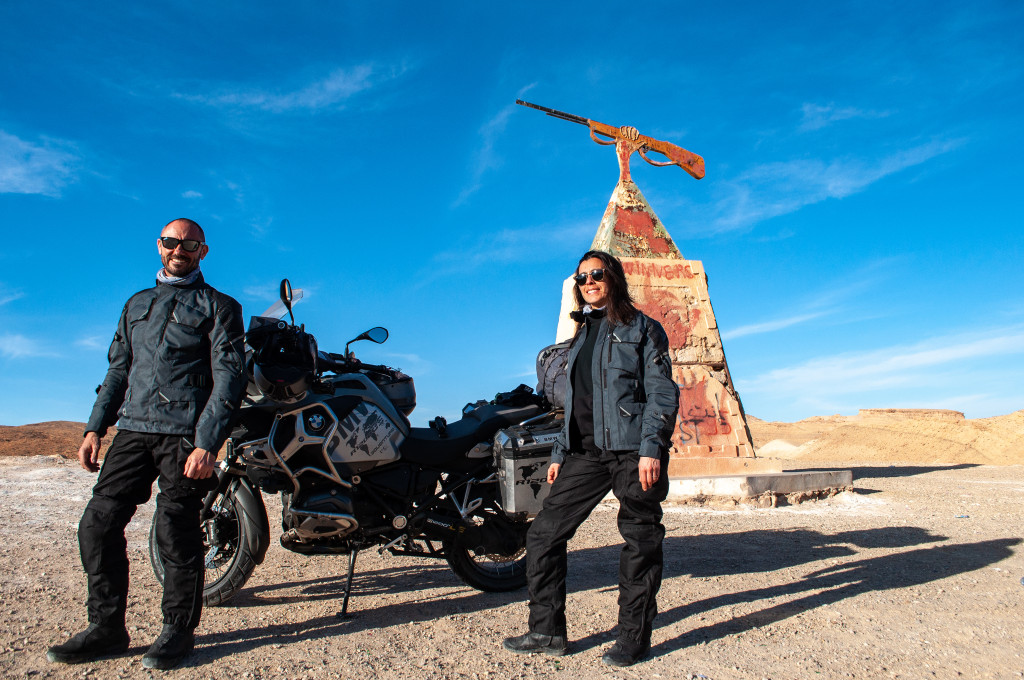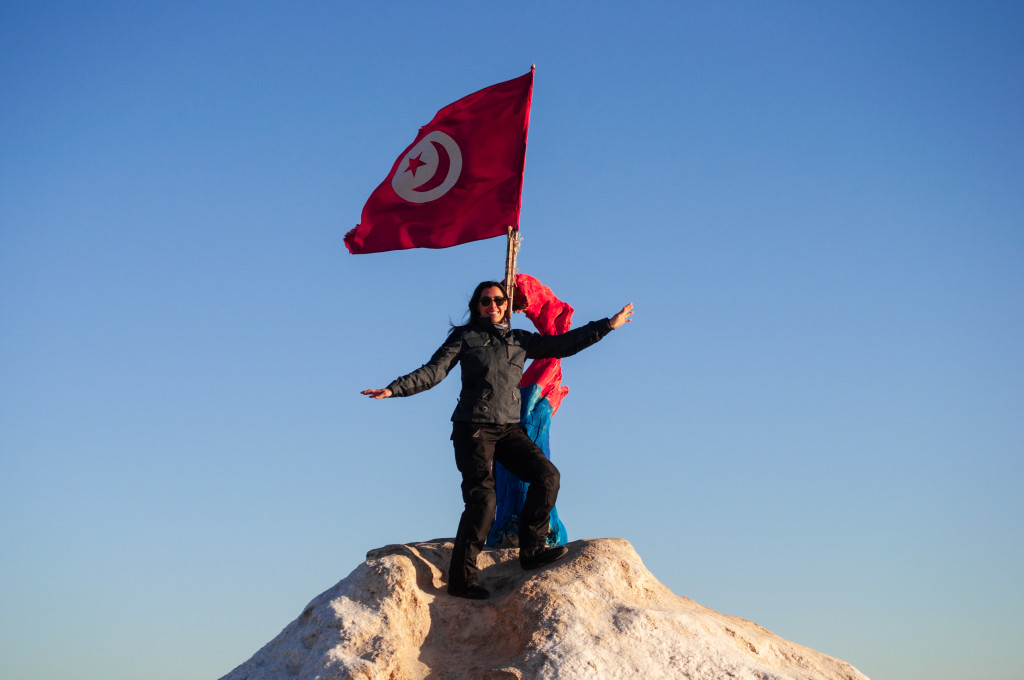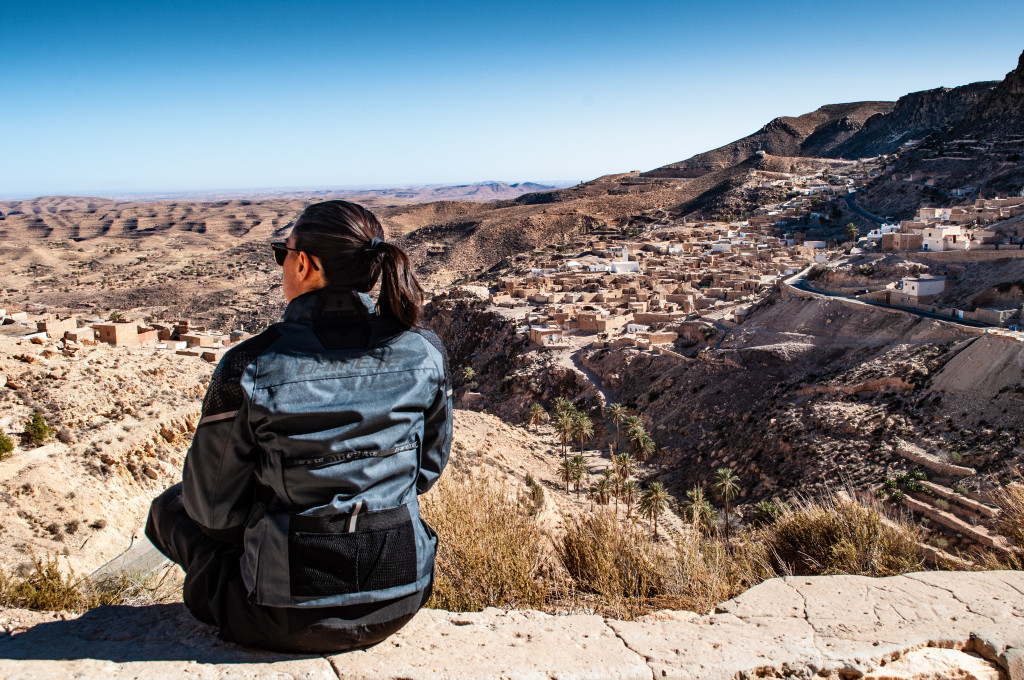
I’m Cinzia, I’m 39 years old, I’ve been riding a scooter for a long time and I love adventure. Before I met Massimiliano, I mainly traveled by plane, backpacking and enjoying a lot of freedom. Once our paths crossed, however, I started following him on his travels and then, quite naturally, the motorcycle became our vehicle to explore the world.
I’m Massimiliano, I’m 47 years old. I’ve been riding motorcycles since I was four or five years old, a passion that my family kindled, when my parents gave me my first moped. I grew up with sporty motorcycles, then I got into Maxi enduro ones, and now I can no longer do without them. In the saddle, I can fully breathe in the world that flows by me, the smells of the places I pass through, and I get to know the people who inhabit it.
The idea of this journey started almost as a joke, so to speak. It was around September, at 6 a.m., we were at a gas station with some friends and, while chatting, I said to Cinzia, “What about going to Tunisia for Christmas and New Year?” At first, Cinzia was a bit skeptical. She wasn’t 100% convinced, but as the hours, days, weeks passed, what was a mere notion turned into a decision, and then it became an adventure.
It’s December 24, Christmas Eve, in Pavia, it’s 8 °C and drizzling. Not too bad. We thought it might be much worse. We go down to the garage, put on our Tourmodular helmets, connect the Cardo intercoms and fire up the boxer engine. Our hearts seem to beat in synch with the GS engine. We open the automated door and our tour begins. Destination: The Port of Genoa.
While riding toward Genoa, the rain lets off and the temperature starts rising. It’s 14 °C when we reach the port. We’d never thought it could be so mild, considering the time of year. We get in line and begin the long check-in procedure. A veritable slow and disorganized nightmare. The ship had to leave at 4 p.m. but left at about 6 p.m.
The red tape continues on the ship, as the customs officers and the Tunisian police require us to fill in more forms (concerning us and the motorcycle). We reach the end of paperwork and queue at 12.30 a.m. OK, finally we can go to bed. Tired, stressed out, but all in all relieved. Tomorrow we’ll only have to think about disembarking and crossing the border. The African continent awaits us.

The day after, December 25, the ship reaches Tunis a full two hours early. We disembark and go through border controls very quickly, we leave the port at about 5 p.m. The sun is setting and we admire our first Tunisian sunset. The colors are just enchanting.
We head straight to Hammamet, where we’ll spend the night, as we booked a nice, large room overlooking the sea at the Bel Azur Hotel. Our room is just about three meters from the sandy beach. We settle in, take a shower and go out to look for a place for dinner. We find a small local restaurant a stone’s throw from the hotel. Seafood dinner for about €30 each – not cheap for Tunisia, we know, but we’re in Hammamet, which is a tourist resort. We take a walk then get some rest – tomorrow, a lot of kilometers await us.
The next day, the alarm goes off early. We have breakfast at 7 a.m. and it’s beautifully sunny outside. We take a walk on the beach before leaving the hotel. The horizon is misty, due to the large temperature variation between night and day. The motorcycle is wet from the high humidity.
The temperature is of about 6 °C. I decide to apply the D-dry membrane to the Ladakh 3L jacket, so as to shelter myself from the cool air, but I don’t wear the additional layers for my pants, which later turns out to be a good choice. It proved to be a delightful ride up to 10.30 a.m. Then I took off the membrane and continued on, ‘feeling lighter’.
Humidity is now just a memory. It’s 18 °C when we reach Monastir, an ancient port that’s become a major tourist hub. The city was founded on the ruins of Ruspina, still visible. The stop in Monastir also includes a visit to the wonderful El Ribat Fort – a majestic building overlooking the sea to protect the town. It’s the city’s main attraction, as well as the site of the mausoleum of Tunisia’s first president. Inside the Fort, you can visit the Museum of Islamic Art. The full ticket costs eight dinars, just under €3.
We visit the medina, get lost amidst the alleys, stalls, smells and noises. The locals “pester” us as if there was no tomorrow. We zigzag to avoid them – their goal, obviously, is to get us into their stores.
Back in the saddle and off we go, our compass needle still pointing south: Toward El Jem, a truly enchanting place.
In earlier times, El Jem used to be the ancient Roman city of Thysdrus, one of the most important cities in North Africa after Carthage. The amphitheater was built around the third century A.D. and could seat an audience of up to 35,000 people. A veritable feat of engineering. We take the opportunity to have some lunch and enjoy a small break. The temperature is now over 24 degrees. “It’s all fine and dandy”, as we often say.
From there on, our trip continues to Sfax, where we’ll stay at the wonderful Sfax Business Hotel, which offers all conceivable comforts. We have a large, bright room on the 4th floor. Nice views and safe parking for the motorcycle. A shower and we’re off to discover Sfax.
Unfortunately, we don’t get to visit the medina. Given the time of year, it shuts at 5 p.m. as it gets dark soon after. No matter, we take the opportunity to get lost in the streets of Sfax until we find a place for dinner. The usual walk after dinner and back to the hotel. We do our routine check on tomorrow’s itinerary and we’re off to bed.
On the morning of the 27th, the alarm goes off early, earlier than usual, actually. At 6.15 a.m. we go up to the ninth floor for breakfast and feel quite emotional contemplating the red glow on the horizon. The sun is rising and we’re the only ones there. In silent appreciation, we admire the skyline that unfolds before our eyes. It’ll be one of the most beautifully colorful breakfasts of the journey.
Today, our trip gets in full swing. We’re heading to a part of Tunisia that we hope will thrill us, will make our hearts beat faster. We choose to ride a few miles on the highway, to get closer to Matmata.
It proves to be a good decision. We leave the highway and the road acquires a really magical feeling. Perfect asphalt and sinuous bends. Around us, everything is ochre colored, the sky is blue and in no time at all we’re in Matmata, visiting the famous Berber dwellings. Cinzia has a pleasant encounter with a baby dromedary, such a sweet thing.
The troglodyte dwellings found in these parts are dug into the ground at a depth of about 15-20 meters, as this allows to keep an average temperature of 18 °C to 20 °C inside them. Keep in mind that in these parts, in August, temperatures rise to about 45 °C to 50 °C – a real hell.
We leave Matmata and continue along roads that are simply magnificent. We cross plateaus at 400 to 450 meters above sea level, surrounded by yellow mountains and shrubs. We have lunch on the road, the way we like it – it’s not a financial question, it’s simply because in this way there are no constraints and we can stop when and where we want, fully enjoying the journey, our dream, our freedom.
After lunch, the journey continues along sparsely trafficked roads surrounded by wild and rugged nature. The temperature rises but thanks to our versatile three-layer clothing we’re delightfully comfortable. We reach Medenine. Tonight, we made a reservation at Maison d'Hotes La Cuesta, a pleasant accommodation found on Airbnb, close to the center of town and moderately priced: €55 with breakfast included and reserved parking. We take a shower and off we go to explore the town and, in particular, the ancient fortified granaries. In the meantime, the sun sets and the city fades along with the sunlight. We find a place in the center to have dinner. We enjoy a traditional dinner and we’re off home – another wonderful day full of sights awaits us tomorrow.
12/28/22: Medenine – Tataouine. Today we won’t travel too much. By the end of the day we’ll have done just under 250 km, packed with excitement and beauty, however. Let's start with a bang: Ksar Ouled Soltane, the site of the most beautiful and well-preserved fortified granaries in Tunisia. A real gem, absolutely worth the trip!
From here, our itinerary continues to another Tunisian wonder: Chenini. A Berber rock village, inhabited by a few dozen people, which rests contentedly on the top of one of the many surrounding mountains. You can hardly tell it apart from the rock face. Crumbling houses and stone blend into one, only the white tower of the old mosque stands out. From the top of the village, the views are amazing.

The sunlight is excellent, so we take the opportunity to get some souvenir shots, with our lovely GS this time, which, despite its almost 180,000-km mileage, tolerate and supports us without flinching. We wait here for the sunset, then check-in at Dar Essadeg, a private home we rented, an entire three-bedroom apartment with a nice terrace for only €35. Simple and modest, but central and comfortable.
On the morning of the 29th, the alarm goes off early. Breakfast at home and then coffee on the road. Today, too, we admire a majestic sunrise. In front of us are splendid red mountains. We pass them and start savoring the feeling of having reached the desert. Meanwhile, the thermometer has dropped to 1 °C! We stop for a change of gloves, off with the light ones and on with the padded ones. Now we’re comfortable. We’re still wearing the lightweight version of the pants, with no membrane or thermal lining, while we keep an extra layer on the jacket, to stop the cool air from entering.
In no time at all, we find ourselves in the middle of the desert. We’re riding on a strip of black asphalt that cuts through this sea of sand with a thousand shades ranging from red to yellow. Wonderful. Needless to say, we’re the only ones here. From here, after about 80 km (still in the middle of the desert), we reach one of the most renowned places in Tunisia: Ksar Ghilane. An amazing oasis with a hot spring water pool nestled in a palm grove. Enchanting. From here, we head toward the city of Douz, to see the incredible “Gateway to the Desert”. A gateway to the desert indeed, beyond which the immense expanse of sand opens up before our eyes.
From here, we pass through palm groves and oases to reach the town of Kebili. We’ll stay with Latifa and Arafat, hosts found on Airbnb – one night with breakfast included for about €30. We take the opportunity to have dinner here. I purposefully ask Arafat and Latifa to dine with us, as not only we’d prefer to feel like their guests rather than their customers, but also because we’d like to share our journey, our experience, with them, and get better acquainted with their traditions, habits and customs. We have a delightful dinner with local products and dishes; Latifa, Arafat's wife, is an excellent cook.
Tomorrow, one of the most beautiful and thrilling stages of this journey awaits us. The alarm goes off early once more, since daylight doesn’t last long at this time of the year, and once darkness falls, everything stops around here. After a hearty breakfast at Arafat and Latifa's, we get back in the saddle and head toward the salt lake. A truly bizarre place, and we ride through it on our motorcycle. Only an immense expanse of sand and salt lays before us. Magnificent.
We then leave the lake to see some other wonders: The mountain oases. We’ll visit those of Chebika, Tamerza, and Mides, all different from one another, each with its own unique nature and unmistakable colors. They’re all breath-taking, though the majesty of the Mides canyon, just a stone's throw from the Algerian border, is utterly unique.
The village of Mides was swept away by a major earthquake and, several years ago, the clay houses in the oasis of Tamerza couldn’t withstand three weeks of torrential rain, and they melted like snow in the sun. It’s upsetting to see the state of these houses, juxtaposed to such beauty.
We have lunch a few miles from Mides, on the road, just the way we like it. We have everything we need with us. After all, if you have a GS, you can't go around with empty bags – “We don't ride a motorcycle just for a whim”, as people might say! The aluminum bags will be our coffee table, and some bricks our stools. In no time at all, lunch is served.
After lunch, we have coffee at a café in Redeyef and ride down a simply fantastic road that takes us to another of the most photographed and visited attractions in this part of Tunisia – the iconic Rommel Runway, a place filled with charm and history. The road, thanks to the gorgeous afternoon light, is a delight.
We reach our accommodation in Gafsa after about 80 km, the Mounir lodge, which on paper was supposed to be the best of the journey – in reality, however, it turned out to be the worst, despite paying €70 per night. Just as a comparison, we paid less than €50 for 4- and 5-star hotels and had a splendid time.
We’ve reached our penultimate stop on Tunisian soil, it’s New Year’s Eve and tonight we’ll arrive in Kairouan.

Breakfast and off we go, leaving the chaotic Gafsa behind us. The road to Kairouan doesn’t do much for us, it’s just a riding leg. It’s a sunny day – we arrive in Kairouan and check in at the wonderful Continental Hotel, we have a room overlooking the pool. In Kairouan we visit the Aghlabid Basins: Immense reservoirs built in the 9th century, an impressive work of Tunisian engineering. The function of these tanks was to collect water and then channel it via a water system. They’re perfectly round and well preserved.
From here, we head to the medina where, through a maze of streets, we reach and visit the Governor's house, now the site of an important carpet production center. Kairouan, in fact, is where the most beautiful carpets in all of Tunisia are handcrafted. Next, a visit to the Barouta well, the oldest spring in the city. Its peculiarity is that a dromedary works the pump to draw water from the spring. By walking, the animal activates the wheel that allows the blades to rotate and pump water from the spring to the top of the well – you can drink the water, of course.
We go back to the medina and wander around until the sun goes down, when we look for a nice place for dinner. We have our last meal of 2022 at a little roadside kiosk, with sea bream, potatoes and Coke. We go back to the hotel – this is our last night on Tunisian soil, tomorrow night we’ll sleep on the ship.
January 1, 2023: Happy New Year, we should say! An early breakfast once more and off to the north.
Before heading to the port, however, we have plenty of time to visit a unique village overlooking the sea, north of Tunis: Sidi Bou Said. A real gem, a white spot perched on the hillside, with small narrow lanes bustling with artisans and tourists. We reach one of the lookouts and enjoy the spectacle offered by nature.

After a long wait at the port, it’s now time to leave Tunisia and return to Italy. We leave the heat and go back to the cold. Thus, once on the ship, we reassemble our jackets for cold temperatures, and once we arrive in Genoa we’ll also have a chance to test their resistance to water, and to the cold. We did indeed, as it was raining when we disembarked and all the way home, though we nevertheless got back perfectly dry and the cold wasn’t an issue at all.
Having told you about our experience in the saddle and beyond... allow us to add a few words about the outfit we wore. Let's start with the head, to avoid leaving anything out: